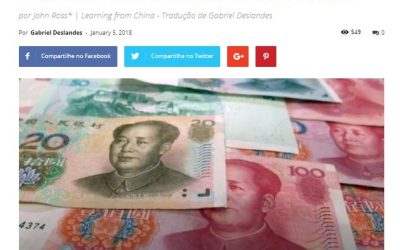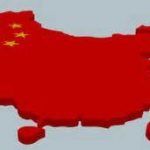These U.S. actions will clearly significantly increase geopolitical tensions. This might superficially appear a very strange action when the official claim by the U.S. government is that geopolitical tension is the greatest downside risk to already relatively slow U.S. economic growth. If increased geopolitical tension will allegedly slow the U.S. economy, and therefore weaken the U.S. in its economic competition with China, such U.S. moves to increase geopolitical tension may appear irrational. More realistic analysis below, however, shows that U.S. provocations in the South China Sea and South Korea are not “despite” the risk of U.S. slow economic growth but “because of” slow U.S. economic growth. Furthermore, attempting to increase geopolitical, and even military, tensions is a necessary result of the slow growth of the U.S. economy.
Attempting to create geopolitical and military tension, for reasons analyzed, will be an increasing feature of US actions towards China – because slow US economic growth means that it is losing economic competition with China. A further and more general analysis of these trends, which form a pattern which in a sense is the opposite of the old “Cold War” rivalry between the USSR and U.S., is provided in the conclusion of this article.
The analysis will start with the geopolitical processes and then trace them to their underlying economic causes.
Chilcot report
The long awaited U.K. Chilcot Report on the invasion of Iraq last week cast a clear light on the conduct of U.S. foreign policy. It officially catalogued that a web of media lies, which were orchestrated by the U.S. government, had been used to prepare that war. The Chilcot Report officially showed in detail:
• processes by which evidence was systematically invented or distorted to claim Iraq possessed non-existent “weapons of mass destruction”
• secret pledges were extracted by the U.S. from allies to agree to circumvent the UN Security Council
• a war was launched not according to the military situation but according to a pre-determined U.S. timetable
As with the Watergate scandal the lies involved were so great at the highest levels of the U.S. government that an official report was forced to admit them – but only, of course, safely 13 years after the invasion.
Given such methods were not only used regarding Iraq but have been repeatedly used by the U.S., as will be analyzed in detail below, it is certain that similar methods of lying and disinformation are being used against China over the South China Sea and to justify deployment of the THAAD system in South Korea.
The South China Sea
Turning to the specific question of the South China Sea, Deng Xiaoping wisely remarked that some problems were best left to be solved by the wisdom of future generations. To put it in more prosaic terms, some situations are unsatisfactory but do not cause an imminent threat, therefore they should not be inflamed at present and are best left to be resolved sometime in the future. Equivalent, if less elegant, the Anglo-Saxon phrases are to “let sleeping dogs lie” or to “put things on the back burner.”
Territorial disputes in the South China Sea are among the clearest examples of this. China is strongly dissatisfied that parts of its territory in the South China Sea are illegally occupied, and that claims are made on its territory by other countries, while other countries claim equivalent dissatisfactions. But meanwhile, despite this, the economic development of South East Asia and China has been proceeding rapidly to the immense benefit of the population of all the countries concerned.
Any rational analysis of benefits and disadvantages therefore shows that the most advantageous course is to proceed with economic development and not attempt to inflame the situation. Indeed, for many years this is what occurred – relations between China and ASEAN were rather harmonious with rapid economic development to the strong benefit of all countries concerned.
Also prior to Abe becoming Japan’s prime minister, China-Japan relations were not as smooth as China-ASEAN relations but tensions were not particularly high. The rapid economic development of China, East Asia, and South East Asia was one of the main drivers of global economic growth and therefore also to the considerable benefit of countries outside these regions.
The series of recent actions, which could clearly only have been taken with the agreement of, or at the instigation of the U.S., has endangered this situation. Japan deliberately inflamed the situation over the Diaoyu Islands before embarking on a more generally aggressive course of remilitarization under Abe. The Philippines launched its unilateral appeal to The Hague Tribunal. The U.S. began a series of provocative voyages and flights of its military aircraft and ships in the South China Sea. As both Japan and the Philippines are entirely dependent for their military protection and economic stability on the U.S., it is clear that provocative actions by these countries could not have been embarked upon without U.S. agreement.
The U.S. record on “international law” and “human rights”
In this overall context, turning to the more strictly defined issue of the Philippines claims to The Hague Tribunal, the particularly ludicrous character of U.S. support for these is evident. Even before getting to any points of international law:
• The U.S. itself refuses to sign the United Nations Convention on the Law of the Seas (UNCLOS) under which the Philippines claims are taking action;
• When, in 1986, The Hague Tribunal declared in favour of Nicaragua, over a case brought against U.S. military support to “contra” rebels in Nicaragua, the U.S. promptly declared that the tribunal had no authority and refused to accept or carry out its ruling.
Even on a narrow point of law, a through report by the U.S. Brooking’s Institute “Limits of Law in the South China Sea” published in May 2016 makes clear the fraudulent nature of the Philippines appeal to The Hague Tribunal and consequently of the U.S. backing to it. The Brooking’s study admitted that “the upcoming ruling in the case brought by the Philippines against China before an arbitration tribunal under the U.N. Convention on the Law of the Seas (UNCLOS) will not solve the problems or even make major headway in resolving them.”
The reason for this is clearly stated:
• regarding countries and UNCLOS “the United States is one of the few that is not [a signatory];”
• “all [countries] concede that the tribunal has no jurisdiction to decide any issues of ‘sovereignty’ over the islands and rocks in the South China Sea;”
• “Article 298 of UNCLOS allows countries to carve out… exceptions to the compulsory remedial procedures, and China and a number of other countries have taken the requisite steps to activate those exceptions… Specifically, Article 298 provides that a state may ‘declare in writing that it does not accept one or more of the procedures.’ Specifically, ‘All [countries] concede that China was within its legal rights under Article 298 of UNCLOS after ratifying the treaty in explicitly exempting itself from compulsory resolution of a swath of issues concerning sea boundary delimitations.'”
In short, the U.S. demands that China submit to a Tribunal regarding a
Convention which the U.S. itself refuses to sign, whose decisions the U.S. has explicitly rejected and refused to carry out, and which has no legal jurisdiction because China has not agreed to be a party to the Tribunal’s arbitration and has activated a long time ago the necessary legal exemptions all countries agreed were lawful. This means the whole procedure is a farce.
This farce is, however, clearly in line with the long established real attitude of the U.S. to “human rights” and “international law.” Far from upholding “international law” the U.S. has waged a series of aggressive wars in Iraq, Libya and elsewhere in which hundreds of thousands of people were killed – not to speak of its earlier war in Vietnam in which well over a million people were killed. Numerous of these wars were carried out without agreement of the United Nations or of international law. Since World War II the U.S. has:
• dropped bombs on the people of more than 30 countries;
• attempted to overthrow more than 50 foreign governments, most of which were democratically elected;
• attempted to assassinate more than 50 foreign leaders.
Furthermore, facts clearly establish that the attacks on China’s human rights and international law record by the U.S. government are simply hypocrisy. China openly states its foreign policy principle – that each country has the right to choose its own form of government, and whether a country wants an absolute monarchy without political rights, a parliamentary republic, or socialism, is not China’s affair. The U.S., in contrast, claims the right to criticize other countries, and interfere in their internal affairs, in the name of supposed “universal values” of Western forms of political rule. But the reality is transparently different to U.S. government claims.
A country such as Saudi Arabia, which is an absolute monarchy, in which political parties are banned, in which women are forbidden even to drive cars, is not subject to U.S. campaigns over “human rights.” Nor is Bahrain, another absolute monarchy which serves as the base for the U.S. Fifth Fleet. U.S. involvement in events such as the military overthrow of Chile’s president Allende is evident, and the U.S. even entirely formally admitted its role in the overthrow of the elected government of Mosaddegh in Iran. In Russia in 1993 the U.S. government supported Yeltsin’s attack with tanks on the Russian parliament.
Such facts establish beyond doubt that the problem for supporters of current U.S. government policy regarding China is not “human rights” or “international law” – if China were an authoritarian regime supporting the U.S. it would not be criticized. The real problem about China for U.S. neo-cons is that China’s national revival makes China strong. It is this, therefore, which both explains the current U.S. actions towards China and what is behind its recent specific provocations over the South China Sea and South Korea.
US tactics towards China
Finally, moving beyond the individual issues to what determines the precise form of U.S. provocations against China, will this pattern continue? This may most clearly be understood by making a comparison of current trends to the old “Cold War” between the U.S. and the USSR.
The USSR was a great military power. Despite its economy reaching at its peak only approximately 45 percent of U.S. GDP, the USSR was in terms of military strength comparable with the U.S. – such a scale of Soviet military build-up was not sensible but that is a different issue. However, by the 1970s, due to errors in policy, the Soviet economy was no longer dynamic. Consequently, the U.S. did not enjoy great military superiority compared to the USSR but it had a much larger economy. Therefore, the strategy of the U.S. was to attempt to transfer all issues onto the economic terrain. Even the Reagan military build-up on the 1980s was not aimed to have a military conflict with the USSR but to overstrain its economy.
The relations of China and the U.S. are almost exactly the reverse. China’s economy is not only much closer in absolute size to the U.S. than the USSR was but China’s economy is also much more dynamic and rapidly growing than that of the U.S. However, the U.S. remains militarily stronger than China. Therefore, it is in the interests of the U.S. to attempt to transfer issues onto the military terrain, in terms of military tension if not of direct wars, and to avoid fair competition with China in the economic field. It is this strategy of attempting to transfer issues onto the military terrain which explains the deliberate U.S. escalation of tension in both the South China Sea and in the deployment of the THAAD missile system in South Korea. China’s interests, on the contrary, lie in peaceful economic development and avoidance of geopolitical and military tensions and conflicts.
It is this situation which explains what initially appear to be irrational US actions to escalate geopolitical tensions – including in the South China Sea and Korea. It also means that in such disputes humanity’s interests lie in the path of peaceful economic development which China logically pursues, rather than in the dangerous escalation of international tensions which the U.S. pursues.






